Abstract
The sequence of the amino-terminal 34 amino acids of γ-heavy chain disease (γ-HCD) protein Hi is homologous with the amino-terminal region of immunoglobulin heavy chains. γ-heavy chain disease is smaller than a normal γ-chain, but has the carboxy-terminal composition expected for γ-chains and must, therefore, contain an internal deletion. Comparison of the Hi sequence with that of γ-heavy chain disease Zu, which also has an internal deletion, indicates that the site of internal deletion is not a constant characteristic of γ-heavy chain disease proteins.
Heavy chains can be assigned to subgroups on the basis of variable region sequences. The variable regions of Hi and one other protein differ significantly from those determined for other heavy chains, and these two proteins are assigned to a new heavy chain variable region subgroup, VHIV.
It has been suggested that single immunoglobulin heavy chains are the products of two separate structural genes and that variable region genetic information is translocated and integrated into common region information. These multiple gene theories make no prediction as to whether DNA or RNA is translocated. γ-heavy chain disease proteins provide unique information that indicates that if translocation is required for the production of immunoglobulin heavy chains, it is DNA, not RNA, that is translocated.
Full text
PDF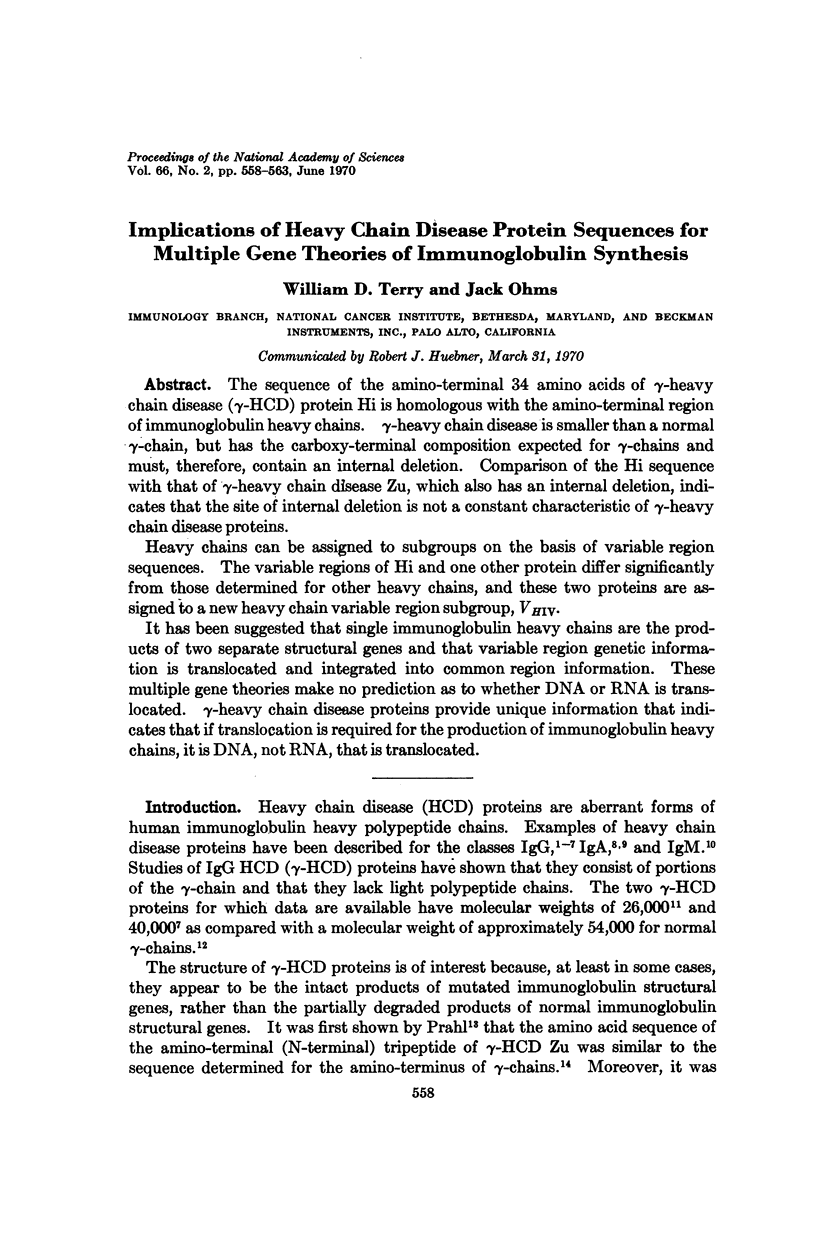

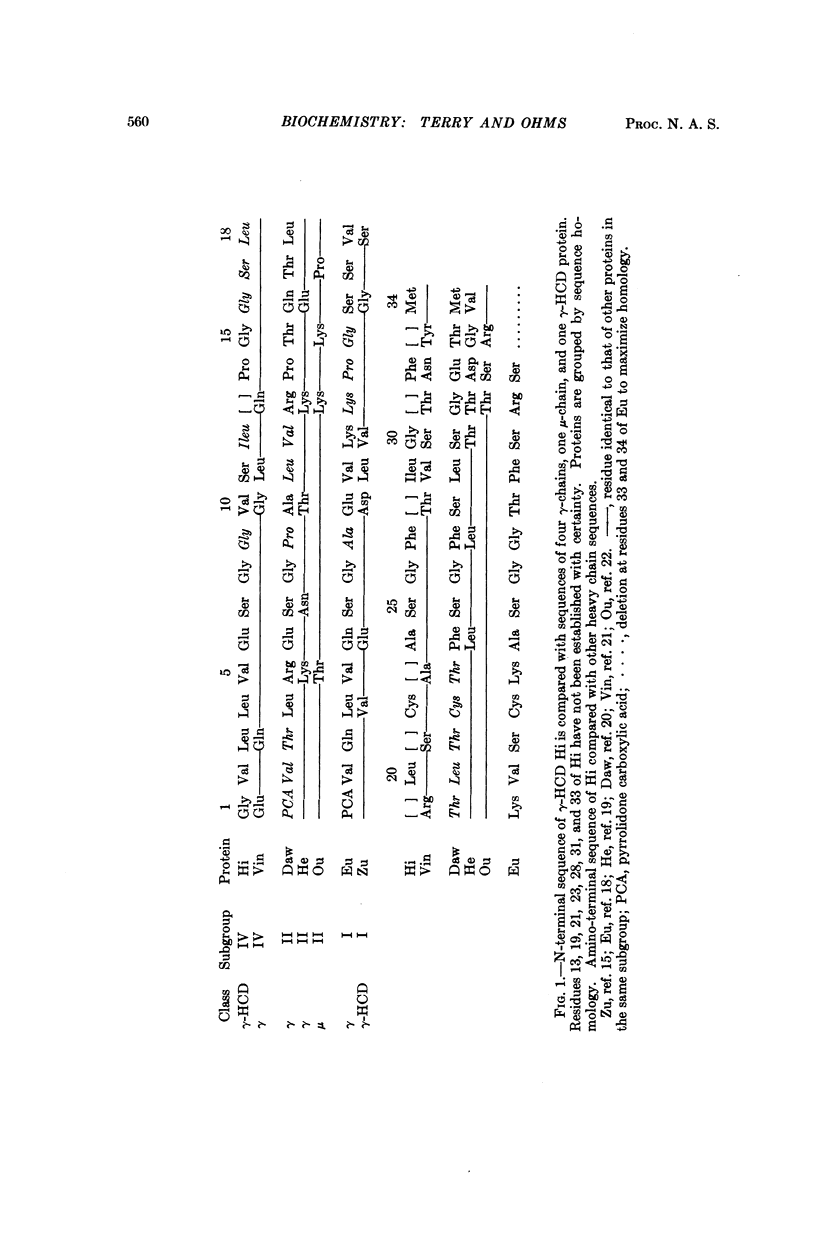
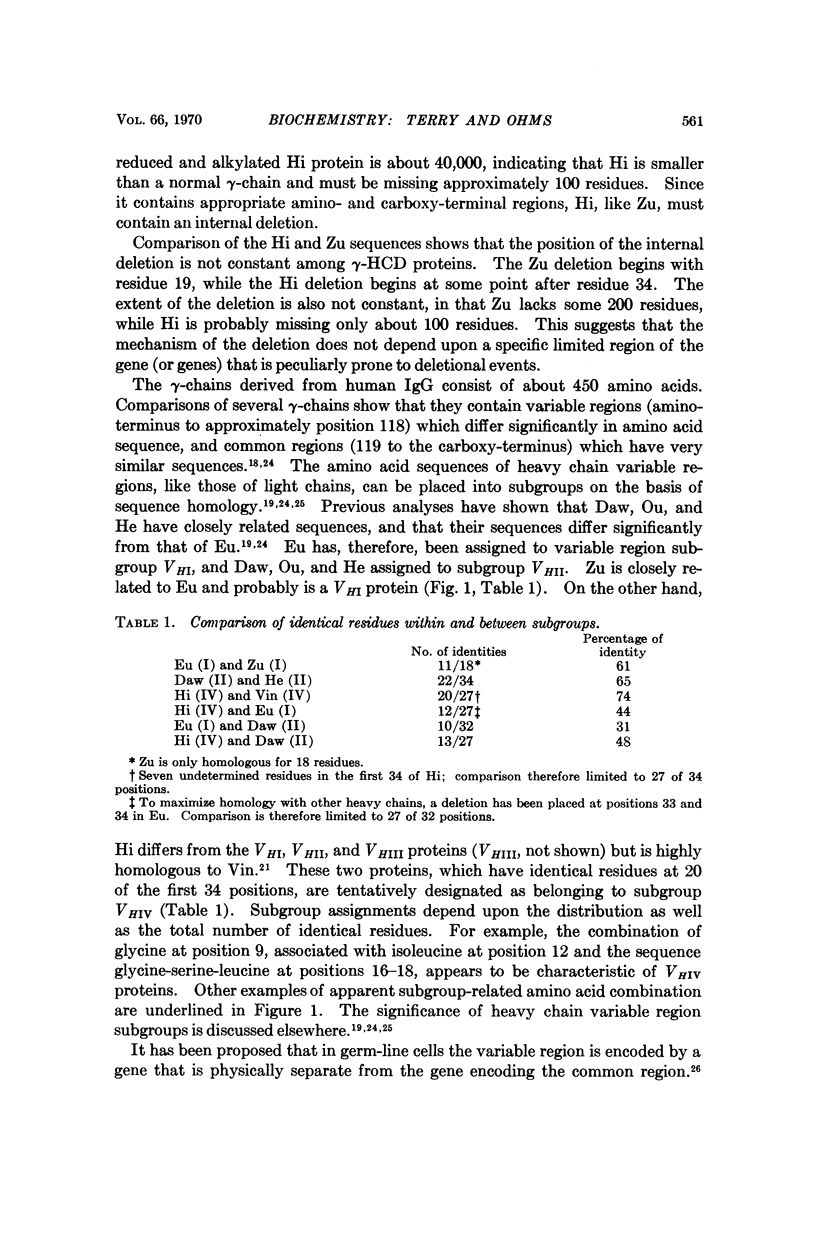
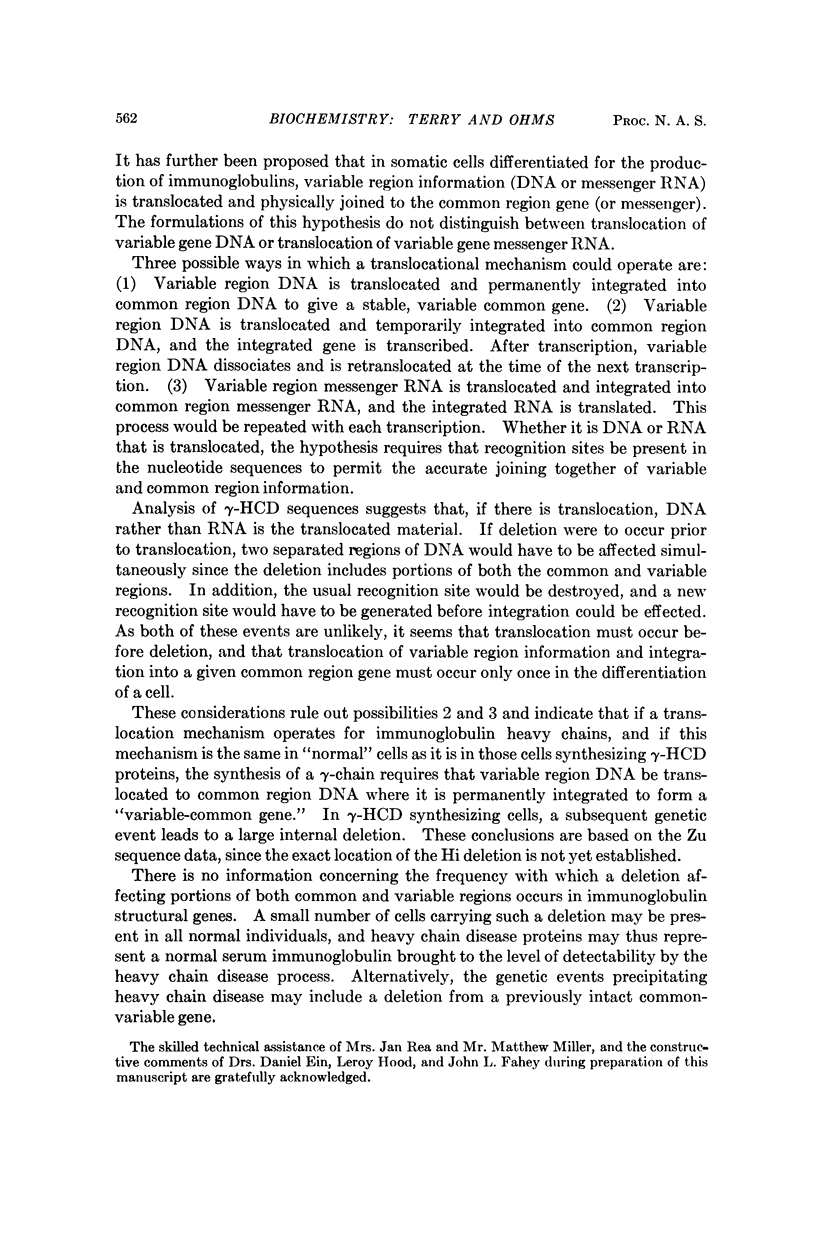
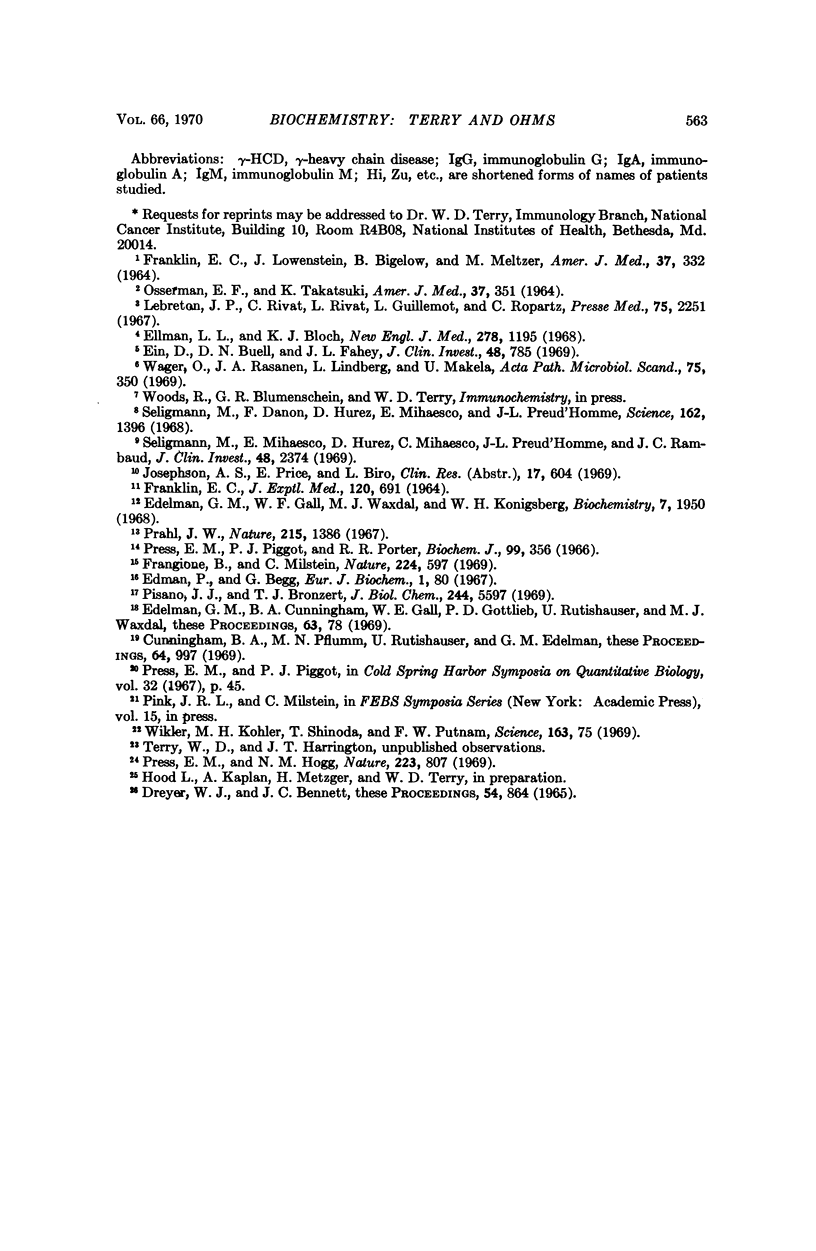
Selected References
These references are in PubMed. This may not be the complete list of references from this article.
- Cunningham B. A., Pflumm M. N., Rutishauser U., Edelman G. M. Subgroups of amino acid sequences in the variable regions of immunoglobulin heavy chains. Proc Natl Acad Sci U S A. 1969 Nov;64(3):997–1003. doi: 10.1073/pnas.64.3.997. [DOI] [PMC free article] [PubMed] [Google Scholar]
- Dreyer W. J., Bennett J. C. The molecular basis of antibody formation: a paradox. Proc Natl Acad Sci U S A. 1965 Sep;54(3):864–869. doi: 10.1073/pnas.54.3.864. [DOI] [PMC free article] [PubMed] [Google Scholar]
- Edelman G. M., Cunningham B. A., Gall W. E., Gottlieb P. D., Rutishauser U., Waxdal M. J. The covalent structure of an entire gammaG immunoglobulin molecule. Proc Natl Acad Sci U S A. 1969 May;63(1):78–85. doi: 10.1073/pnas.63.1.78. [DOI] [PMC free article] [PubMed] [Google Scholar]
- Edelman G. M., Gall W. E., Waxdal M. J., Konigsberg W. H. The covalent structure of a human gamma G-immunoglobulin. I. Isolation and characterization of the whole molecule, the polypeptide chains, and the tryptic fragments. Biochemistry. 1968 May;7(5):1950–1958. doi: 10.1021/bi00845a045. [DOI] [PubMed] [Google Scholar]
- Edman P., Begg G. A protein sequenator. Eur J Biochem. 1967 Mar;1(1):80–91. doi: 10.1007/978-3-662-25813-2_14. [DOI] [PubMed] [Google Scholar]
- Ein D., Buell D. N., Fahey J. L. Biosynthetic and structural studies of a heavy chain disease protein. J Clin Invest. 1969 Apr;48(4):785–793. doi: 10.1172/JCI106036. [DOI] [PMC free article] [PubMed] [Google Scholar]
- Ellman L. L., Bloch K. J. Heavy-chain disease. Report of a seventh case. N Engl J Med. 1968 May 30;278(22):1195–1201. doi: 10.1056/NEJM196805302782203. [DOI] [PubMed] [Google Scholar]
- FRANKLIN E. C., LOWENSTEIN J., BIGELOW B., MELTZER M. HEAVY CHAIN DISEASE- A NEW DISORDER OF SERUM GAMMA-GLOBULINS : REPORT OF THE FIRST CASE. Am J Med. 1964 Sep;37:332–350. doi: 10.1016/0002-9343(64)90191-3. [DOI] [PubMed] [Google Scholar]
- FRANKLIN E. C. STRUCTURAL STUDIES OF HUMAN 7S GAMMA-GLOBULIN (G IMMUNOGLOBULIN). FURTHER OBSERVATIONS OF A NATURALLY OCCURRING PROTEIN RELATED TO THE CRYSTALLIZABLE (FAST) FRAGMENT. J Exp Med. 1964 Nov 1;120:691–709. doi: 10.1084/jem.120.5.691. [DOI] [PMC free article] [PubMed] [Google Scholar]
- Frangione B., Milstein C. Partial deletion in the heavy chain disease protein ZUC. Nature. 1969 Nov 8;224(5219):597–599. doi: 10.1038/224597a0. [DOI] [PubMed] [Google Scholar]
- Lebreton J. P., Rivat C., Rivat L., Guillemot L., Ropartz C. Une immunoglobulinopathie méconnue: la maladie des chaines lourdes. Presse Med. 1967 Oct 28;75(45):2251–2254. [PubMed] [Google Scholar]
- OSSERMAN E. F., TAKATSUKI K. CLINICAL AND IMMUNOCHEMICAL STUDIES OF FOUR CASES OF HEAVY (H-GAMMA-2) CHAIN DISEASE. Am J Med. 1964 Sep;37:351–373. doi: 10.1016/0002-9343(64)90192-5. [DOI] [PubMed] [Google Scholar]
- Pisano J. J., Bronzert T. J. Analysis of amino acid phenylthiohydantoins by gas chromatography. J Biol Chem. 1969 Oct 25;244(20):5597–5607. [PubMed] [Google Scholar]
- Prahl J. W. N- and C-terminal sequences of a heavy chain disease protein and its genetic implications. Nature. 1967 Sep 23;215(5108):1386–1387. doi: 10.1038/2151386a0. [DOI] [PubMed] [Google Scholar]
- Press E. M., Piggot P. J., Porter R. R. The N- and c-terminal amino acid sequences of the heavy chain from a pathological human immunoglobulin IgG. Biochem J. 1966 May;99(2):356–366. doi: 10.1042/bj0990356. [DOI] [PMC free article] [PubMed] [Google Scholar]
- Seligmann M., Danon F., Hurez D., Mihaesco E., Preud'homme J. L. Alpha-chain disease: a new immunoglobulin abnormality. Science. 1968 Dec 20;162(3860):1396–1397. doi: 10.1126/science.162.3860.1396. [DOI] [PubMed] [Google Scholar]
- Seligmann M., Mihaesco E., Hurez D., Mihaesco C., Preud'homme J. L., Rambaud J. C. Immunochemical studies in four cases of alpha chain disease. J Clin Invest. 1969 Dec;48(12):2374–2389. doi: 10.1172/JCI106204. [DOI] [PMC free article] [PubMed] [Google Scholar]
- Wager O., Räsänen J. A., Lindeberg L., Mäkelä V. Two cases of IgG heavy-chain disease. Acta Pathol Microbiol Scand. 1969;75(2):350–352. [PubMed] [Google Scholar]


